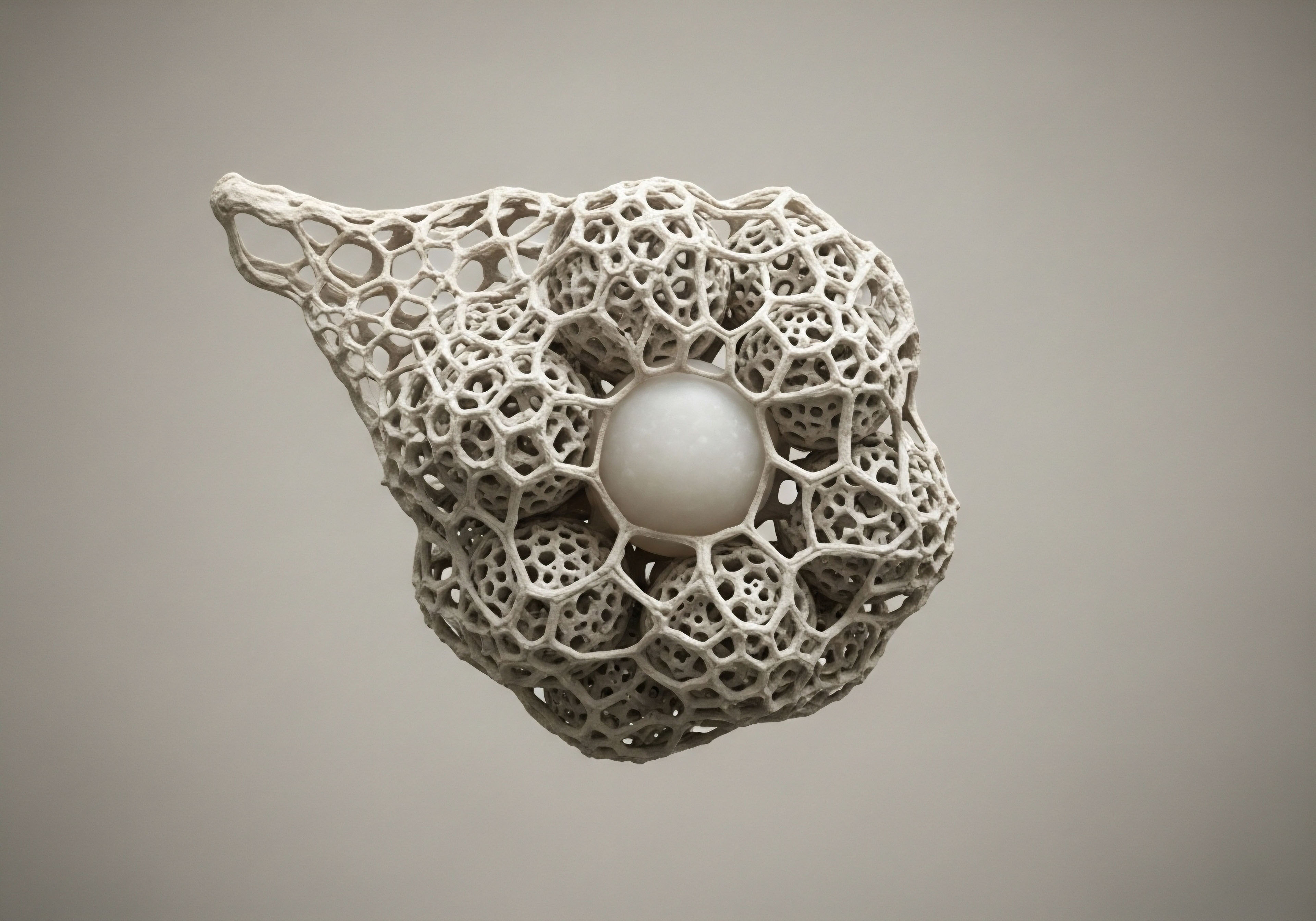

The Biological Premise for Refusal
The standard trajectory of human existence is a negotiated surrender to entropy. This document dismisses that negotiation. Youthful physiology is not a genetic lottery; it is a meticulously managed state, an achievable output of a finely tuned biological machine. The unwritten code reveals that the perceived decline associated with age is, in fact, the result of predictable system degradation within the endocrine command structure. We reject the passive acceptance of diminished capacity.

The Endocrine Axis a Failure of Feedback
The Hypothalamic-Pituitary-Gonadal HPG axis functions as the master control system for vitality, motivation, and structural integrity. Age introduces systemic friction into this feedback loop. The decline in sex steroid signaling is not merely a secondary effect of aging; it is a primary driver of cognitive and physical entropy.
Research confirms that low endogenous testosterone levels correlate with reduced cognitive performance, particularly in areas like spatial ability. The system begins sending lower quality signals to the central command center, resulting in reduced drive and compromised neurological output.

Bioactive State versus Total Mass
A common error is the simple measurement of total circulating hormones. This overlooks the critical gatekeeper ∞ Sex Hormone-Binding Globulin SHBG. As SHBG increases with age, it sequesters the active components, rendering them inert. The true metric of physiological signaling power rests in the bioactive fraction.
A system showing ‘normal’ total T but elevated SHBG is, functionally, a hypogonadal system operating in a fog. This is the first critical insight of the code ∞ total mass is irrelevant without free access to the target receptor.
The functional decline in androgenic negative feedback onto the HPG axis in older men shows a measurable reduction, sometimes exceeding 35 percent, signaling a breakdown in the system’s self-regulation mechanism.

Peptides the Lost Language of Repair
Beyond the primary hormonal regulators, the body possesses an auxiliary communication network essential for repair and regeneration ∞ peptides. These short-chain amino acids are the precision tools for cellular instruction. They modulate inflammation, stimulate angiogenesis, and direct tissue remodeling. The decline in youthful output is compounded by a reduced capacity to deploy these localized repair signals effectively. Re-engaging youthful physiology demands restoring the primary drivers and reactivating these secondary, high-fidelity signaling cascades.


Engineering the Endocrine Command Center
The execution phase transforms theoretical understanding into applied physiology. We approach the body as a complex, multi-layered machine requiring targeted adjustment, not generalized maintenance. The methodology centers on precision calibration of the HPG axis and strategic deployment of regenerative peptides.

Recalibrating the HPG Loop
The goal is to restore the integrity of the entire three-part system ∞ Hypothalamus, Pituitary, and Gonads. This requires assessing the functional responsiveness at each node, not just the peripheral output. The analytical focus shifts to identifying where the signal degradation occurs ∞ is it reduced hypothalamic Gonadotropin-Releasing Hormone GnRH outflow, or diminished testicular response to Luteinizing Hormone LH?
Corrective protocols are then designed to support the weakest link, often involving the administration of bioidentical hormone precursors or targeted analogs to re-establish negative feedback efficiency.

The Multi-Component Strategy
True optimization moves beyond singular metrics. It demands an integrated approach addressing multiple axes simultaneously for synergistic effect. Consider the key components requiring direct intervention:
- Hormone Replacement Therapy HRT Administration of precise doses of testosterone or its active metabolites to restore the neurological and metabolic milieu associated with peak function.
- SHBG Modulation Protocols designed to lower the binding affinity or concentration of SHBG, thereby increasing the concentration of immediately bioavailable sex steroids.
- Peptide Signaling Deployment Specific peptides are introduced to promote cellular instructions for muscle tissue maintenance, vascular health, and focused neural support, bypassing generalized systemic support.
- Metabolic Efficiency Tuning Optimization of nutrient partitioning and insulin sensitivity, which directly impacts the availability and utilization of hormonal building blocks.

The Precision of Peptide Signaling
Peptides are not supplements; they are software updates for cellular machinery. They operate with exquisite specificity. For instance, certain compounds are engineered to enhance the growth factor signaling necessary for rapid structural recovery, supporting tendons, ligaments, and muscle tissue. This targeted action provides a clean, predictable mechanism for mitigating the cumulative micro-damage that accelerates perceived aging.
A 12-week study demonstrated that testosterone substitution could yield moderate positive effects on selective cognitive domains, such as spatial ability, in older men, directly linking endocrine status to observable performance metrics.


Precision Timing for System Recalibration
The efficacy of any advanced physiological protocol is defined by its timing and sequence. Implementing these adjustments randomly results in systemic noise and compromised outcomes. The “When” component dictates the transition from a state of slow decay to one of active ascendancy.

Phase One Establishing the Baseline Signature
The initial 30 to 60 days are dedicated to comprehensive data acquisition and initial stabilization. This period involves mapping the existing HPG axis function, establishing SHBG levels, and profiling the body’s inflammatory and regenerative baseline markers. The primary action is the introduction of foundational support to halt immediate degradation ∞ the systemic equivalent of stopping the water leak before renovating the foundation.

Phase Two the Optimization Window
Following initial stabilization, the primary intervention period commences. This phase demands unwavering consistency, typically spanning six to twelve months. This duration allows for the biological system to fully integrate new hormonal feedback patterns and for peptide signaling to induce structural remodeling. Cognitive shifts often precede physical changes; expect early reports of enhanced focus and motivation as central nervous system steroid signaling improves.

Temporal Markers of Progress
Progress is tracked not by subjective feeling alone, but by quantifiable shifts in the biomarkers that govern system health. We monitor for specific changes that validate the protocol’s effectiveness:
- Six Weeks ∞ Noticeable shift in sleep architecture and morning energy quality.
- Three Months ∞ Measurable reduction in inflammatory markers and improved strength curve recovery post-exercise.
- Six Months ∞ Re-testing of key endocrine markers showing increased free T fractions and normalized LH/FSH feedback dynamics.
- Twelve Months ∞ Validation of structural gains through body composition analysis and sustained improvements in cognitive domain testing.
This is a sequential deployment. Introducing aggressive peptide stacks before stabilizing the core HPG function introduces unnecessary variables that obscure the true performance gains. Patience in the sequencing delivers exponential returns in the outcome.

The New Baseline of Human Output
The Unwritten Code of Youthful Physiology is the recognition that biology is not destiny; it is a complex, solvable equation. The standard medical framework treats the symptoms of systemic failure; this methodology addresses the control architecture itself. The knowledge shared here is not permission for indulgence; it is a mandate for total operational command over your biological asset.
We have detailed the ‘Why’ ∞ the failure of passive aging. We have defined the ‘How’ ∞ the systems engineering of the endocrine command center. We have charted the ‘When’ ∞ the sequential deployment for verifiable results. The next step is an act of self-determination. Cease managing decline. Begin designing ascent. Your physiology is not a fixed inheritance; it is a dynamically tunable platform for superior output. The architecture of your future performance begins with this absolute ownership of your internal chemistry.



